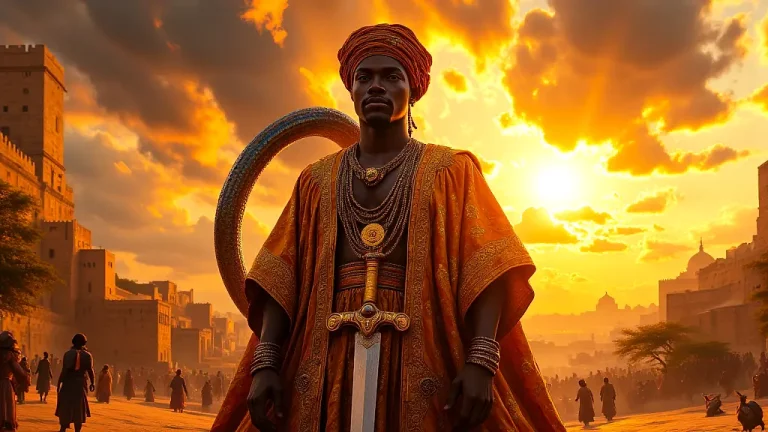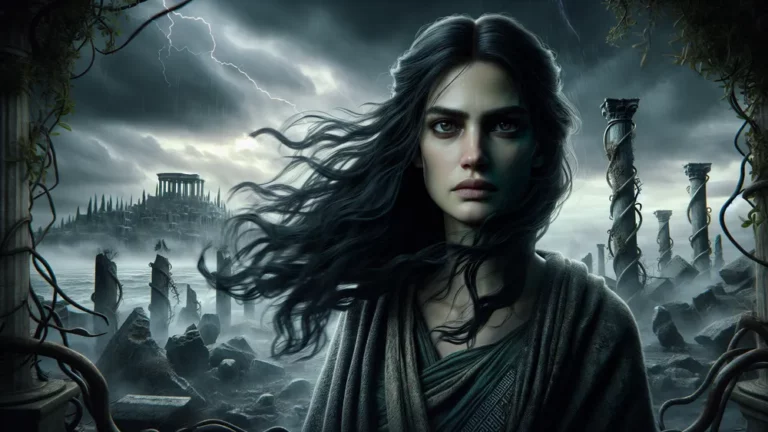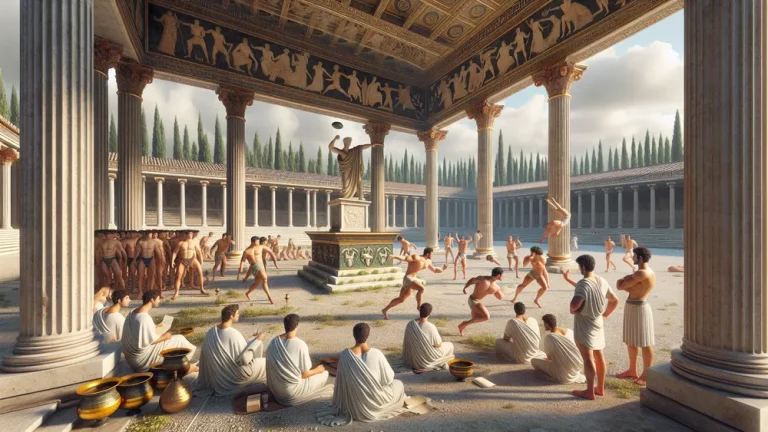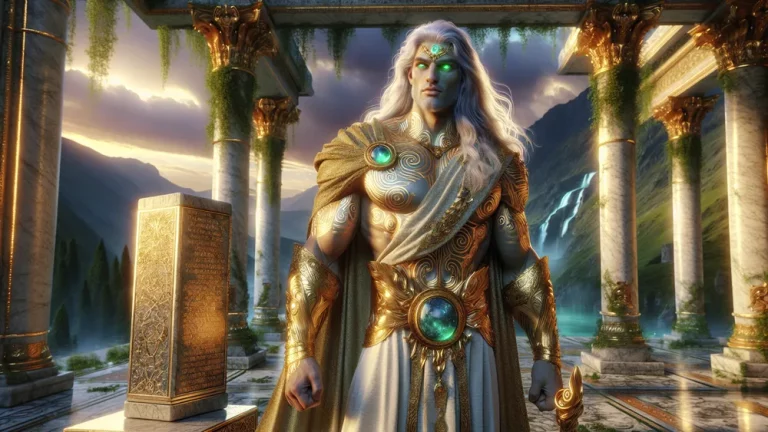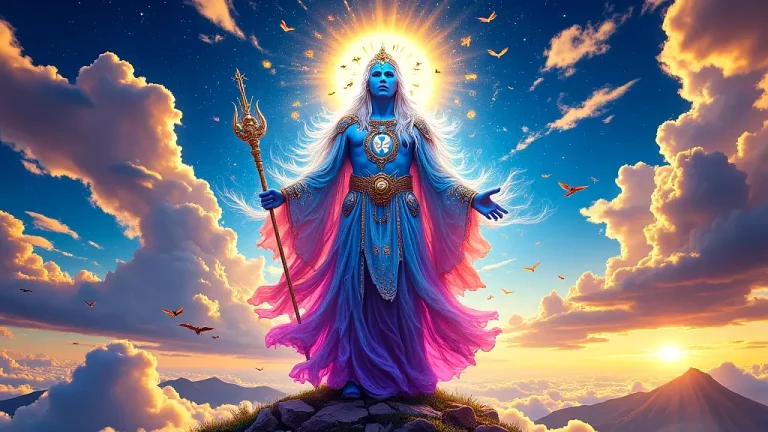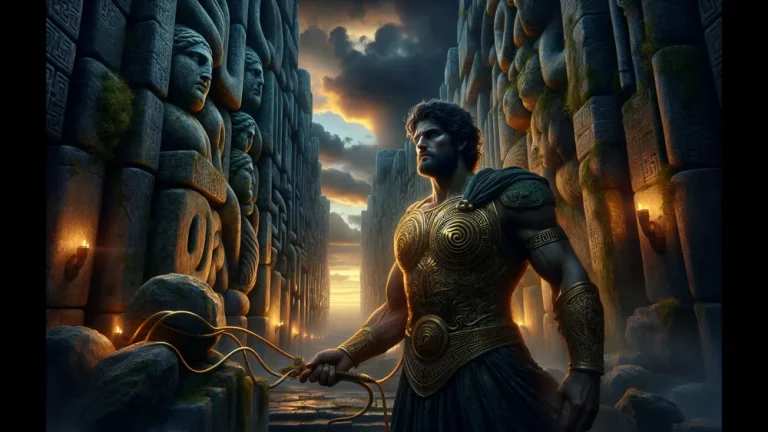Orthosie: Greek Goddess Of Prosperity And One Of The Horae
Greek mythology is packed with gods, goddesses, and other figures, holy or mystical, that people connected to the natural world or ideas for how to live. Some, even though they’re important, are still less well-known. Orthosie is one of these. She is one of the Horae, a group of godly beings who stand for either natural cycles or virtues of life.
Key Points:
- Orthosie is one of the Horae, goddesses tied to virtues or nature’s cycles.
- She represents prosperity, which includes growth, success, and balance in Greek life.
- Orthosie’s name means prosperity or progress and links to both wealth and well-being.
- She is less mentioned in myths but ties to festivals and farming rituals like Thalysia.
- Orthosie connects society’s progress with nature’s harmony and agricultural abundance.
- She is part of the second group of Horae, focusing on virtues rather than seasonal changes.
- Orthosie’s role highlights how prosperity helps communities thrive in balance with nature.
The Horae are split into two groups, and each reflects a different way ancient people thought. The first group is about seasons and how they change. The second group is more about ideas like peace, justice, and well-being. Orthosie is in the second group. Instead of seasons, she is connected to prosperity, which is a key thing people cared about in Greek times.
Orthosie, unlike well-known ones like Dike (Justice) or Eirene (Peace), is harder to figure out because there aren’t a lot of stories or writings about her. However, she still matters. Her role ties to how people imagined prosperity as something necessary for both individuals and communities.
This blog will focus on Orthosie’s role, her relationship with societal life, her ties to nature, and how she represents prosperity as something Greek culture valued deeply.
Orthosie: Overview and Key Facts
| Aspect | Details |
|---|---|
| Name | Orthosie (Ὀρθωσίη in Greek), meaning “prosperity” or sometimes “progress.” |
| Pantheon | Greek |
| Role | Goddess connected to prosperity. She is part of the second group of Horae, who stand for virtues tied to nature and society. |
| Domain | Prosperity. For the Greeks, this included good crops, personal happiness, and community progress. |
| Group | One of the later Horae, who were not linked to the seasons like the earlier ones were. |
| What it Stands For | Orthosie is tied to growth, success, and progress, both for individuals and for communities. |
| Related Figures | Linked with others like Eunomia (Good Order), Dike (Justice), and Eirene (Peace), who stood for similar ideas. |
| Mentions in Stories | Orthosie’s name is barely mentioned directly. Most of her details come from how she connects to other Horae and their myths. |
| Importance | Orthosie played a quiet, powerful role in ancient Greek life. People called on her to bring wealth and growth to everyone. |
| Significance | She reflects the idea that progress and well-being were central to how Greeks saw the link between humans and nature. |
Who Is Orthosie?
To really understand Orthosie and why she matters in Greek mythology, we need to learn about her part in the Horae and her special link to prosperity. The Horae, a unique group of gods, are connected to both nature and human life, and Orthosie stands out because of what she brings to this group.
Let us take the time to look further at who Orthosie is and what she represents. Her role, though not talked about as much as other gods, connects directly to ideas of growth and success, which were central to ancient Greek life.
Orthosie as One of the Horae: An Overlooked Goddess of Prosperity
Orthosie is part of the second set of Horae, a group of goddesses tied to keeping both nature and people organized in Greek mythology. The first group included Thallo (Blooming), Auxo (Growth), and Carpo (Harvest), and they were connected to how seasons changed and how crops grew. Their work helped nature stay in balance year after year.
But the second-generation Horae were different. Instead of focusing on seasons or nature’s rhythms, they worked on ideas like laws, fairness, and peace. This second group includes Orthosie, Eunomia (Good Order), Dike (Justice), and Eirene (Peace). While Eunomia, Dike, and Eirene are often mentioned in old writings like Hesiod’s Works and Days, Orthosie’s name comes up much less. You don’t see her in many big stories.
That’s likely because her connection to prosperity – which means success, wealth, or growth – was harder to pin down than clearer ideas like law or peace. Prosperity is not easy to describe as a single image the way peace or justice might be. Still, Orthosie’s part in the group mattered. She worked for growth and progress in both nature and daily life, helping both sides work together.
Like the other Horae, her role can be compared to an unseen but necessary piece in a system that allows everything else to function smoothly. Without her, things likely wouldn’t run the way they were meant to.
Orthosie, part of the second group of Horae, focused on prosperity and progress, helping nature and daily life work together, even though her role is less mentioned in Greek myths.
What Orthosie’s Name Tells Us About Her
The name Orthosie (Ὀρθωσίη in Ancient Greek) means “prosperity” or “progress,” which covers what her divine role is all about. In ancient Greece, names held deep meaning. Often, a god’s power was tied directly to the ideas their name described. This belief means that a god’s name was never separate from what they really controlled. Orthosie’s name stands for the idea of people and communities growing, thriving, and doing well.
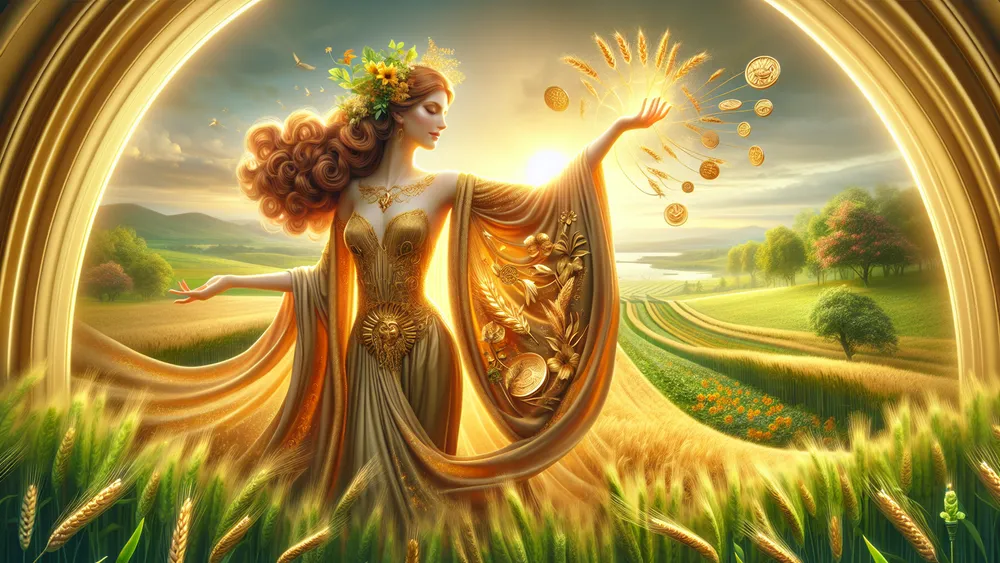
She is linked to economic success, peaceful living, and personal achievements. In ancient myths about the Horae, this use of names continually points to how each goddess makes their purpose clear. For example, Thallo means “blooming,” which fits with spring and plants, while Auxo stands for “growth,” or how crops develop. Within this system of names, all of the Horae represent something specific. Eunomia stands for lawfulness, Dike for justice, and Eirene for peace.
Their names are tied to their purposes in life and nature. Orthosie, with her focus on “prosperity,” works well with this system. Although her name is less talked about than others, it still plays a critical part in showing her work for both people and the world around them.
- List of the Horae and their Symbolism:
- Thallo: Blooming; tied to spring and new plants.
- Auxo: Growth; involved in the way plants and crops grow.
- Carpo: Harvest; tied to the end of the farming cycle.
- Orthosie: Prosperity; connected to success and thriving.
- Eunomia: Good Order; focused on laws and peace in society.
- Dike: Justice; responsible for fairness and balance.
- Eirene: Peace; ensuring unity and calm in communities.
Through these names, the Horae clearly align with ideas that shaped both nature and human life.
Orthosie’s work for prosperity is a vital part of this, even though it is not mentioned as often.
Orthosie’s Part in Greek Prosperity
Orthosie’s role in prosperity goes further than just her name. She wasn’t just tied to what prosperity means; her work played a big part in how the Greeks thought about growth, balance, and living well. What Orthosie represented mattered to both their communities and the way their land gave back to them. Ancient ideas about abundance and harmony were shaped by her importance.
This didn’t stop at farming or wealth; her role also influenced how people saw success in society, how they worked together, and how both nature and humans thrived. Orthosie’s position shows us connections between what people hoped for in their lives and how their world worked together to make that growth possible.
What Prosperity Meant to the Ancient Greeks
To the Greeks, prosperity wasn’t simply about money or material things. It was a much bigger idea. It included things like the growth of communities, healthy crops from fertile land, and people doing well, both physically and socially. Prosperity also meant balance – between humans and the world around them, between people in society, and between people and the gods they believed in.
Orthosie, the goddess tied to prosperity, stood for all these forms of success. She wasn’t only connected to farming and food, which were essential for survival, but also to the unity needed for a city-state to work. For example, modern prosperity might mean a country is doing well by letting all parts of society grow evenly.
Orthosie symbolized the same thing for the ancient Greeks, linking plenty of resources with peace and fairness in how people lived together. While Orthosie’s stories don’t appear as often in mythology as those of gods like Demeter, she still had a critical place.
Prosperity, for the Greeks, was about living in harmony with each other and with nature, and Orthosie’s role in making that happen made her critical, even if her name isn’t always brought up in surviving texts.
Aligning the Seasons with Prosperity in Greek Agriculture
The Horae, as goddesses of both nature and society, had a vital part in keeping the seasons on track, which strongly affected how the Greeks grew their food. Orthosie, closely tied to prosperity, was linked to these seasonal patterns. She stood for the good outcomes that came when everything in nature worked as it should – like more crops, better weather, and full harvests.
Since farming in Greece depended on carefully watching the seasons, the Horae were seen as guardians, helping to keep those changes steady and predictable. For the Greeks, this meant being able to grow grain in spring and gather it in summer without fear of something going wrong. Orthosie’s link to these processes represents the success that came from working alongside nature.
Farming was not just about labor; it was also about knowing the right times and trusting in the flow of the seasons. For the Greeks, their survival rested on agriculture – not only for food but also for money and trade. The Horae fit into this world as spiritual protectors. While Orthosie is not often named in rituals or festivals, her role connected her to them.
Seasonal festivals like the Thalysia, a time to give thanks for the harvest, and the Skirophoria, which prepared for the next farming year, often pointed to the balance of nature the Horae represented. What these goddesses did mattered, not only to the land but also to society as a whole.
By marking the times to plant, grow, and harvest, the Horae helped keep farming steady. Orthosie, as part of this divine group, stood for prosperity, which meant not only having plenty to eat but also living in a stable, balanced society.
Ancient Greek beliefs tied success in farming to order and harmony, and Orthosie was an example of how everything working together could lead to a better life for everyone.
Celebrations Dedicated to Orthosie and the Horae
The Horae, seen as protectors of natural order and human prosperity, were called upon in many farming festivals that marked important times of the year. These events let communities thank the gods for good harvests and prepare for the next planting season that depended on nature working as it should.
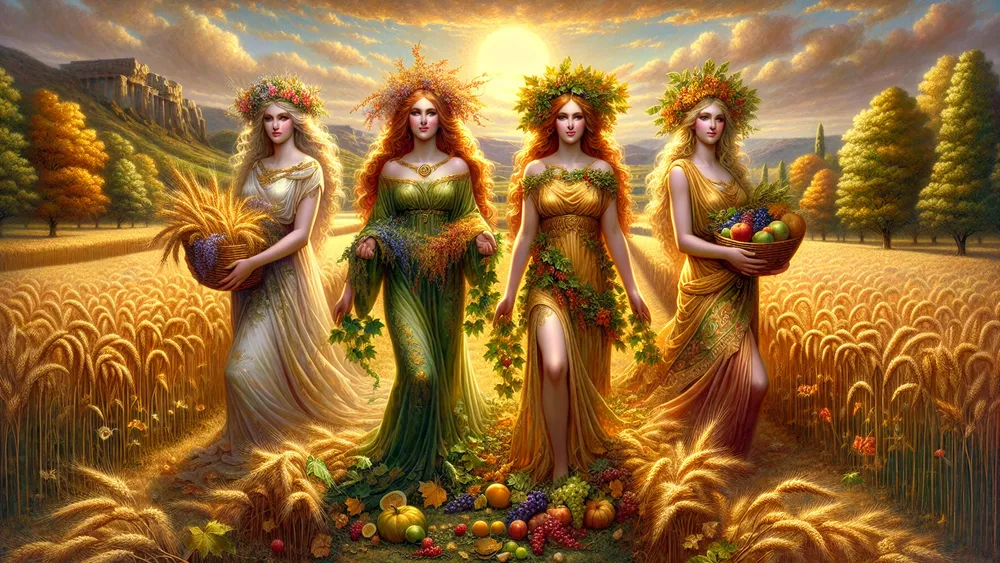
Orthosie, tied to prosperity, was connected to these rituals, especially those where people celebrated after successful crop cycles. For example, the Thalysia honored agricultural gods like Demeter, combining the offering of first fruits with the belief that the Horae kept the seasons on track. Another important festival, the Skirophoria, sought to protect crops during dry months and keep farming steady.
Even though Orthosie’s name wasn’t mentioned directly in these rituals, what she stood for – prosperity – tied her to them.
- Key Agricultural Festivals Related to the Horae:
- Thalysia: Celebrated after the harvest, it honored success in farming with offerings of grain and fruit.
- Skirophoria: Focused on protecting crops from drought and keeping food resources steady.
- Haloa: This festival celebrated planting, linking fertility of the land to people’s work and nature’s balance.
Through festivals like these, Greek communities looked to the Horae for balance and believed their role helped farming succeed. Orthosie, part of this divine group, represented the idea that prosperity came from nature, human effort, and the gods working together properly.
Orthosie’s Place in Stories and Literature
Orthosie plays a significant role in Greek myths and appears in many old stories where the Horae are central figures. In myths and writings, what she means often ties to prosperity and balance, themes closely connected to the natural order and human life. What makes Orthosie’s role significant is how she connects to these cultural and symbolic stories.
Below, her presence in Greek works is looked at, along with what she stood for in the context of mythological events. These stories point to her connection with themes of prosperity and how her meaning fits into the larger group of the Horae.
Mentions of Orthosie in Ancient Greek Writings
Orthosie, a second-generation Horae, is not mentioned clearly in many ancient Greek writings. Instead, her importance is understood through what the Horae as a group represented: natural order and prosperity. In Hesiod’s Works and Days, the Horae are introduced as the daughters of Zeus and Themis. These goddesses were believed to oversee the flow of time and how the seasons stayed balanced.
Hesiod only names the first-generation Horae – Eirene, Eunomia, and Dike – but later traditions connect Orthosie to the second-generation Horae and ideas of prosperity and growth. It is harder to see Orthosie’s individual role in myths because she mainly appears alongside her sisters. Stories written by authors like Pausanias, in his Description of Greece, talk about the Horae during festivals and rituals.
These writings focus more on their group importance rather than what each sister meant by herself.

- Key Ancient Sources Mentioning the Horae:
- Hesiod’s Works and Days: Talks about the Horae as goddesses of time and seasons.
- Homer’s Iliad: Describes the Horae as gatekeepers, keeping things in order on Olympus.
- Pausanias’s Description of Greece: Mentions festivals and offerings made to the Horae, especially in farming.
- Orphica (Orphica Hymns): Includes hymns praising the Horae as those who control growth and seasons.
Through these writings, it is clear that Orthosie’s identity blends with her sisters. This means her role in prosperity is mainly understood as part of her connection to the collective Horae and their harmony with nature.
Orthosie is best understood as a goddess of prosperity whose role blends into the shared importance of the Horae in keeping natural order and balance.
Orthosie’s Part in the Wedding of Zeus and Hera
The wedding of Zeus and Hera mattered a lot in Greek mythology because it meant the joining of heavenly powers and balance. The Horae, as their attendants, made sure the event had blessings of peace, growth, and good fortune. Orthosie, even though not always clearly named, was present because she symbolized prosperity, both in material and spiritual ways.
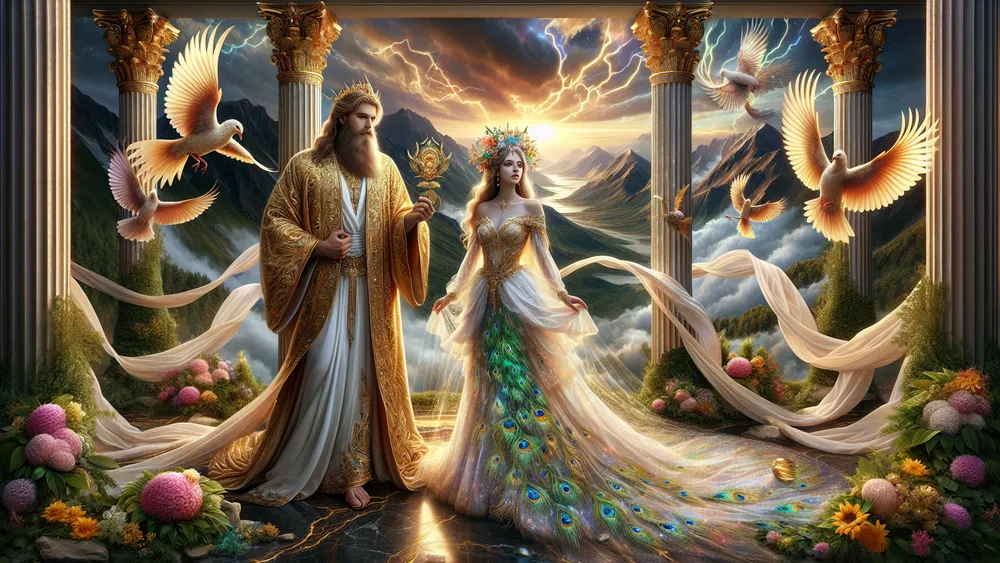
The Horae often appear adding flowers and natural beauty, which shows their job was to bring harmony both in the heavens and on Earth. Their role wasn’t just seasonal – it meant a bigger idea of steadiness. What Orthosie stood for closely tied her to the message of the wedding.
It wasn’t just about the marriage of two gods but also about riches and balance the event promised to both Olympus and nature below. She added blessings of growth and success. Her presence backed the idea that this wedding would lead to flourishing in every way. The Horae being part of events like this shows their role wasn’t small. It was important.
Each Hora added something. Orthosie meant prosperity. Her sisters brought peace, fairness, and growth. Together, they proved that divine harmony – and human success – happen only when every part works as one. Orthosie, in this sense, worked as more than just a goddess of prosperity. She symbolized the wealth and growth humanity and the heavens needed for lasting balance.
What Each Horae Represents
The Horae were daughters of Zeus and Themis, and they were divided into two groups. Each group focused on different aspects of life. The first-generation Horae – Eirene (Peace), Eunomia (Good Order), and Dike (Justice) – stood for things that kept society running smoothly, like fairness, law, and peace. People in places like Athens worshipped them as symbols of leadership and unity.
The second-generation Horae, which included Orthosie (Prosperity), Thallo (Blooming), and Auxo (Growth), were connected more to nature. They looked after things like seasonal changes and making sure crops grew well. Orthosie, in particular, was linked to the idea of prosperity. This wasn’t just about wealth but also about good crops, strong communities, and general well-being.
Each of the Horae had a role to play, making sure that both nature and society stayed balanced. The table below explains how the two groups are different and what they each focused on. It also highlights how each Hora played a part in keeping things steady in both daily life and the world around them.
| Horae Generation | Name | Domain or Symbolism | Role in Harmony |
|---|---|---|---|
| First Generation | Eirene | Peace | Worked for peace and good relationships in society. |
| Eunomia | Good Order | Helped make sure laws and leadership were fair. | |
| Dike | Justice | Stood for fairness and punishments for wrongdoing. | |
| Second Generation | Orthosie | Prosperity | Represented success, farming, and material wealth. |
| Thallo | Blooming | Took care of plants growing and springtime arriving. | |
| Auxo | Growth | Made sure everything grew properly and stayed fertile. |
As this comparison highlights, each Hora had their own focus while working together as a group. Orthosie’s role in prosperity tied together both human life and nature, making sure success spread between communities, seasons, and rituals. Every part of life was connected, and the Horae helped manage it all.

How the Horae Define Nature and Balance
The Horae are closely tied to both how people live and how nature works. They have important roles that act as links between society and the natural patterns that keep the world moving, and their work matters a lot in making sure everything stays steady.
By connecting the lives of humans with what happens in nature, the Horae help life to run properly and without problems. Through their roles, they explain the importance of balance, both in how people organize their lives and in how nature’s cycles are maintained. Orthosie, who focuses on prosperity, has a specific part in this effort.
In the next sections, what each of them adds will be explained, and how they keep society and nature working together will also be discussed.
Maintaining the Balance Between Nature and Civilization
The Horae represent how nature and human life work together. They connected the patterns of the natural world with the ways people organized their lives. Their roles were important because they made sure that the changes in nature, like the seasons, matched well with how people worked and lived. Orthosie, whose focus was on prosperity, played an especially key role in linking these two sides.
Her work meant making the earth’s productivity, like healthy crops and good weather, turn into the wealth and resources that helped communities grow. In ancient societies, including Greece, prosperity was deeply tied to how nature worked. Things like successful harvests, fertile land, and steady weather were critical for survival. Without them, cities and towns were at risk of falling apart.
And each Hora, led by their own domains, contributed to keeping life in balance. Orthosie, in particular, made sure that the blessings of nature turned into real things that people needed – such as food, wealth, and the safety of their communities. But Orthosie didn’t stop at just giving material wealth. Her influence also touched on the well-being of society as a whole.
If the seasons went well, agriculture flourished, which lowered struggles over resources and improved the lives of people. In turn, this balance allowed for peace and progress. To the ancient Greeks, nature and civilization weren’t separate. Instead, they were seen as parts of one system, connected by goddesses like Orthosie. Through her role, she ensured prosperity wasn’t just about surviving – but thriving.
Rituals were held for the Horae, where people prayed for help from goddesses like Orthosie. They believed her prosperity brought gifts that connected nature’s abundance to human success. This harmony between the earth and society explained why the Horae, with Orthosie’s guidance, were so important to life in ancient Greece.
Orthosie’s Link to Fertility and Agriculture
The role of Orthosie in farming and fertility was one of her most important contributions. She stood for the kind of prosperity that came from good harvests, connecting healthy crops and productive seasons to the overall success of the community. In ancient Greece, where farming played a central role in life, Orthosie’s importance could not be ignored.
Unlike Demeter, who looked after how crops grew and stayed safe, Orthosie focused on bigger things. She meant the kind of prosperity that farming brought to everyone – things like enough food for the community, steady wealth, and the stability people needed. While Demeter was connected to personal stories, such as losing her daughter Persephone, Orthosie worked differently.
What Demeter cared about were smaller, individual events, but Orthosie worked on the larger picture. Through Orthosie, the success of farms and fields turned into the resources communities relied on to survive. For example, a successful season wasn’t just about crops – it meant better food, better trade, and peace within the region.
In farming societies like ancient Greece, prosperity and survival depended deeply on nature. Orthosie connected the productivity of the earth with the health of human life. Her blessings were not just about farming itself but also about what came with it: wealth, growth, and stability for the people.
This is why Orthosie’s work mattered so much – not just in fields, but in how Greek communities thrived.
The Greek Gods of Nature and Ideas
The Greek gods were part of a big and complicated system. They had gods for almost everything – some controlled parts of the natural world, like the seasons, while others stood for intangible ideas, like love or justice. This group of gods also included spirits and beings connected to concepts people believed were important for life.
Deities like Orthosie tied things like prosperity to farming and how well communities thrived. This means that ideas that were central to Greek society weren’t just ideas – they linked those ideas to gods. The Horae connected natural patterns, like how the seasons changed, with how people organized their lives. They’re just one example, though.
There were also gods connected to things like fairness, fear, relationships, and even the stars above. For a full list of Greek Natural and Abstract Forces, and to see how different gods worked together, visit this detailed guide.
FAQs
1. Why is Orthosie lesser-known compared to her sisters?
Orthosie is lesser-known compared to her sisters because her domain of prosperity was often overshadowed by more prominent Horae like Dike, Eirene, and Eunomia, who represented universally recognized societal virtues.
2. Are there myths solely devoted to Orthosie apart from the Horae?
There are no myths solely devoted to Orthosie apart from the Horae, as her role is primarily contextual within the collective representation of natural order and prosperity.
3. How did Orthosie’s role compare to Demeter’s in agricultural prosperity?
Orthosie’s role in agricultural prosperity focused on general abundance and societal flourishing, whereas Demeter specifically governed the fertility of the earth and grain harvests.
4. Are there rediscovered artifacts or ruins linked to Orthosie today?
Artifacts or ruins specifically linked to Orthosie today have not been definitively identified, as her cult and worship remain obscure in the archaeological record.

